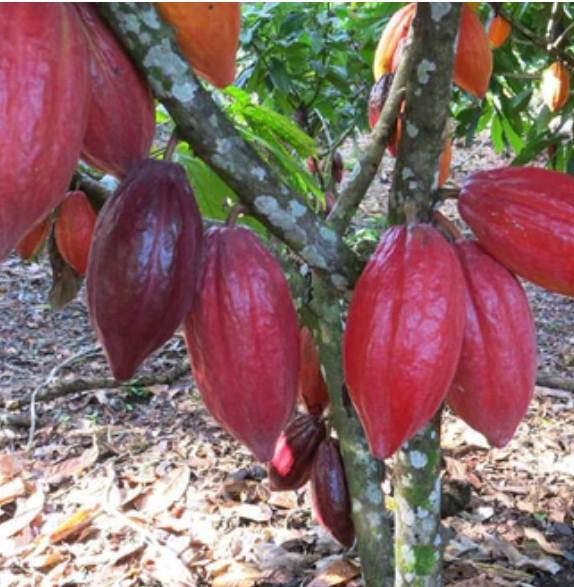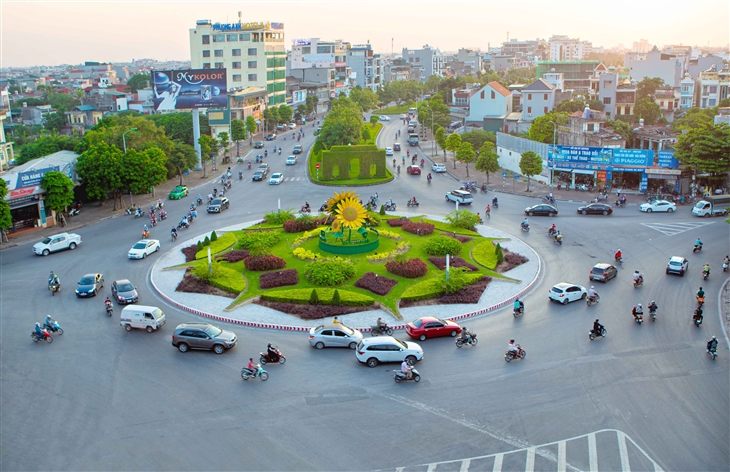Indigenous Trinitario flavor opens export prospects for Vietnamese cocoa
Friday, October 31,2025
AsemconnectVietnam - Indigenous Trinitario cocoa helps Vietnam open up opportunities to export high-end chocolate, attracting investment in domestic processing.
Vietnamese cocoa prices increase 5 times
According to Agriculture and Food Research Department of Wells Fargo Bank (USA), cocoa prices have more than doubled since the beginning of 2024, putting great pressure on chocolate manufacturers. Although wholesale prices have decreased slightly compared to a peak at the end of 2024, food companies still have to adjust products to compensate for increased costs.
Many major brands such as Hershey or Mars have applied "narrow inflation", which means keeping selling price the same but reducing product sizes, while cutting seasonal chocolate lines to limit production costs. American consumers will therefore face record-high chocolate prices for Halloween 2025.
The underlying cause is a severe decline in cocoa production in West Africa, which accounts for more than 70% of global supply. According to International Cocoa Organization (ICCO), global cocoa production in the 2023-2024 crop year will decrease by 12.9% compared to the previous year, to only 4.37 million tonnes, creating a deficit of 494,000 tonnes, the highest in more than 60 years. Meanwhile, global chocolate consumption remains high, especially in Europe and North America, causing market to fall into a serious shortage.
Analysts predict that cocoa production in the four main producing countries in West Africa (Ivory Coast, Ghana, Nigeria and Cameroon) may decrease by another 10% in the 2025-2026 crop year, starting in October 2025. Supply deficit is forecast to last until at least 2026, making it unlikely that cocoa prices will cool down.
Impact of the world's "price fever" has quickly spread to Vietnam. According to the Vietnam Coffee - Cocoa Association, since the beginning of 2025, cocoa market has also experienced many strong fluctuations, with fresh cocoa prices in Vietnam in early May 2025 reaching 14,000-16,000 VND/kg and 220,000-260,000 VND/kg of dry beans, 3-5 times higher than the same period in 2024 and 4-5 times higher than in 2022.
Global supply shortage, with a decrease of about 0.6 million tonnes compared to demand, is the main reason for the spike in cocoa prices. Ivory Coast and Ghana - accounting for 70% of the world's cocoa production - are being affected by climate change, drought and pests, raising concerns among buyers.
Sharp rise in cocoa prices is putting pressure on supply chain. Cooperatives are having difficulty raising capital to purchase raw materials, while limited domestic production leads to fierce competition.
Consumer market only accepts a retail price increase of about 15%, while input costs have increased many times, pushing global chocolate industry into the risk of a supply chain breakdown.
Opportunities for sustainable recovery and reaching the high-end market
According to Ministry of Agriculture and Environment, up to now, cocoa area in Vietnam is only 3,471 hectares, of which the harvested area is 2,836 hectares, with an output of 4,786 tonnes of dry beans, with an average yield of 16.9 quintals/hectare. Cocoa production is concentrated in the Central Highlands, Southeast, Mekong Delta and South Central Coast.
Compared to a period of 2012-2013, cocoa area and output have decreased sharply, mainly because the economic efficiency of cocoa trees is not as high as other crops, causing many farmers to switch to growing coconut, durian or other fruit trees with higher value. Therefore, although cocoa prices have increased sharply, total domestic output is still limited, not enough to meet processing and export needs.
Currently, a number of enterprises have implemented a model of linkage and investment in concentrated cocoa production, such as Thanh Dat Cocoa Trading Service Company Limited, Binon Cacao Company with a production - processing chain combined with experiential tourism. Companies such as Trong Duc, Cao Nguyen Xanh, Puratos Grand-Place Vietnam...have also developed large concentrated cocoa areas, ensuring 100% of cocoa beans are fermented, meeting quality requirements of the processing and export markets.
Vietnam has great potential with indigenous Trinitario cocoa variety, which is highly appreciated in the international market. Many major chocolate brands have opened factories in Vietnam, prioritizing on-site processing of raw materials for export, targeting high-end segment.
Mr. Justin Jacquat, Cocoa Manager for the Asia-Pacific region, commented that although Vietnam's cocoa output is about 3,500 tonnes/year, still modest compared to Malaysia or Indonesia (200,000 tonnes/year), its unique flavor helps Vietnam dominate the high-end segment. To promote this advantage, the industry needs to focus on deep processing, applying high technology and building a sustainable chain from farmers to businesses.
It is expected that in 2025, cocoa area can increase by about 500 hectares. The industry needs to prioritize the development of growing areas that meet international standards, ensuring traceability and stable quality. Intercropping cocoa with coffee, cashews or bananas, which require less care, can bring double economic benefits, but must be accompanied by systematic planning and advanced techniques.
In addition, in context of international processing enterprises looking for alternative sources of supply to West Africa, Vietnam has opportunity to restore cocoa trees in a sustainable direction. If it can build a standard raw material area, Vietnam can completely become a supplier of high-quality cocoa for the region.
However, experts warn that cocoa is an industrial crop that requires long-term investment and high technology, not suitable for spontaneous models. Lack of planning and management, along with unsuitable soil conditions, can lead to negative consequences. The industry needs to avoid repeating the situation like coffee or pepper, where sudden increases in output once caused a surplus crisis. A sustainable strategy, focusing on quality and high-end markets, is the key factor for Vietnam to rise in the Southeast Asian region.
To take advantage of the opportunity, agricultural sector needs to promote program of supporting high-yield, disease-resistant varieties; training in fermentation, drying and preservation techniques that meet international standards. At the same time, it is necessary to attract businesses to invest in deep processing, producing cocoa powder, cocoa butter and chocolate, to increase added value instead of just exporting raw materials.
A new trend is emerging: sustainable cocoa and low-carbon traceability, meeting EU, Japanese and US market standards. Applying certifications such as Rainforest Alliance, Fairtrade or Organic not only helps Vietnamese cocoa access high-end markets but also elevates brand of Vietnamese agricultural products on the world map.
Source: Vitic/ congthuong.vn
According to Agriculture and Food Research Department of Wells Fargo Bank (USA), cocoa prices have more than doubled since the beginning of 2024, putting great pressure on chocolate manufacturers. Although wholesale prices have decreased slightly compared to a peak at the end of 2024, food companies still have to adjust products to compensate for increased costs.
Many major brands such as Hershey or Mars have applied "narrow inflation", which means keeping selling price the same but reducing product sizes, while cutting seasonal chocolate lines to limit production costs. American consumers will therefore face record-high chocolate prices for Halloween 2025.
The underlying cause is a severe decline in cocoa production in West Africa, which accounts for more than 70% of global supply. According to International Cocoa Organization (ICCO), global cocoa production in the 2023-2024 crop year will decrease by 12.9% compared to the previous year, to only 4.37 million tonnes, creating a deficit of 494,000 tonnes, the highest in more than 60 years. Meanwhile, global chocolate consumption remains high, especially in Europe and North America, causing market to fall into a serious shortage.
Analysts predict that cocoa production in the four main producing countries in West Africa (Ivory Coast, Ghana, Nigeria and Cameroon) may decrease by another 10% in the 2025-2026 crop year, starting in October 2025. Supply deficit is forecast to last until at least 2026, making it unlikely that cocoa prices will cool down.
Impact of the world's "price fever" has quickly spread to Vietnam. According to the Vietnam Coffee - Cocoa Association, since the beginning of 2025, cocoa market has also experienced many strong fluctuations, with fresh cocoa prices in Vietnam in early May 2025 reaching 14,000-16,000 VND/kg and 220,000-260,000 VND/kg of dry beans, 3-5 times higher than the same period in 2024 and 4-5 times higher than in 2022.
Global supply shortage, with a decrease of about 0.6 million tonnes compared to demand, is the main reason for the spike in cocoa prices. Ivory Coast and Ghana - accounting for 70% of the world's cocoa production - are being affected by climate change, drought and pests, raising concerns among buyers.
Sharp rise in cocoa prices is putting pressure on supply chain. Cooperatives are having difficulty raising capital to purchase raw materials, while limited domestic production leads to fierce competition.
Consumer market only accepts a retail price increase of about 15%, while input costs have increased many times, pushing global chocolate industry into the risk of a supply chain breakdown.
Opportunities for sustainable recovery and reaching the high-end market
According to Ministry of Agriculture and Environment, up to now, cocoa area in Vietnam is only 3,471 hectares, of which the harvested area is 2,836 hectares, with an output of 4,786 tonnes of dry beans, with an average yield of 16.9 quintals/hectare. Cocoa production is concentrated in the Central Highlands, Southeast, Mekong Delta and South Central Coast.
Compared to a period of 2012-2013, cocoa area and output have decreased sharply, mainly because the economic efficiency of cocoa trees is not as high as other crops, causing many farmers to switch to growing coconut, durian or other fruit trees with higher value. Therefore, although cocoa prices have increased sharply, total domestic output is still limited, not enough to meet processing and export needs.
Currently, a number of enterprises have implemented a model of linkage and investment in concentrated cocoa production, such as Thanh Dat Cocoa Trading Service Company Limited, Binon Cacao Company with a production - processing chain combined with experiential tourism. Companies such as Trong Duc, Cao Nguyen Xanh, Puratos Grand-Place Vietnam...have also developed large concentrated cocoa areas, ensuring 100% of cocoa beans are fermented, meeting quality requirements of the processing and export markets.
Vietnam has great potential with indigenous Trinitario cocoa variety, which is highly appreciated in the international market. Many major chocolate brands have opened factories in Vietnam, prioritizing on-site processing of raw materials for export, targeting high-end segment.
Mr. Justin Jacquat, Cocoa Manager for the Asia-Pacific region, commented that although Vietnam's cocoa output is about 3,500 tonnes/year, still modest compared to Malaysia or Indonesia (200,000 tonnes/year), its unique flavor helps Vietnam dominate the high-end segment. To promote this advantage, the industry needs to focus on deep processing, applying high technology and building a sustainable chain from farmers to businesses.
It is expected that in 2025, cocoa area can increase by about 500 hectares. The industry needs to prioritize the development of growing areas that meet international standards, ensuring traceability and stable quality. Intercropping cocoa with coffee, cashews or bananas, which require less care, can bring double economic benefits, but must be accompanied by systematic planning and advanced techniques.
In addition, in context of international processing enterprises looking for alternative sources of supply to West Africa, Vietnam has opportunity to restore cocoa trees in a sustainable direction. If it can build a standard raw material area, Vietnam can completely become a supplier of high-quality cocoa for the region.
However, experts warn that cocoa is an industrial crop that requires long-term investment and high technology, not suitable for spontaneous models. Lack of planning and management, along with unsuitable soil conditions, can lead to negative consequences. The industry needs to avoid repeating the situation like coffee or pepper, where sudden increases in output once caused a surplus crisis. A sustainable strategy, focusing on quality and high-end markets, is the key factor for Vietnam to rise in the Southeast Asian region.
To take advantage of the opportunity, agricultural sector needs to promote program of supporting high-yield, disease-resistant varieties; training in fermentation, drying and preservation techniques that meet international standards. At the same time, it is necessary to attract businesses to invest in deep processing, producing cocoa powder, cocoa butter and chocolate, to increase added value instead of just exporting raw materials.
A new trend is emerging: sustainable cocoa and low-carbon traceability, meeting EU, Japanese and US market standards. Applying certifications such as Rainforest Alliance, Fairtrade or Organic not only helps Vietnamese cocoa access high-end markets but also elevates brand of Vietnamese agricultural products on the world map.
Source: Vitic/ congthuong.vn
Main commodity groups imported from New Zealand in 9 months of 2025
Import and export surpassed 700 billion USD mark
Cashew nut exports maintain steady growth momentum
Global coffee output in 2025 - 2026 crop year is forecast to reach a record
Vietnam’s pork market in October 2025
Vietnam’s seafood market in October 2025
Vietnamese goods overcome technical barriers, penetrate deeply into New Zealand market
RCEP creates new momentum for small and medium-sized enterprises to integrate internationally
Vietnam’s steel market in October 2025
Main commodity groups exported to New Zealand in first 9 months of 2025
Exports to Laos increased by 79.7% in first 9 months of 2025
Vietnam Fertilizer Market – October 2025
Vietnam’s animal feed market in October 2025: Prices continue to decline
Vietnam's seafood exports to the EU have increased sharply in the first 8 months of 2025 thanks to EVFTA

Plan of Hai Duong province for a period of 2021 - 2030, ...
Organize space reasonably and harmoniously, focusing on connecting Hai Duong in common development space, actively contributing to the ...Plan of Hau Giang province in a period of 2021 - 2030, ...
Sustainable forestry development program in a period of ...

LION Championship 25 to feature title showdowns in Khanh ...
LION Championship 25 will take place at Cam Ranh Square in south-central Khanh Hoa province, at 20:00 on August 16, featuring two of the ...Bai Dinh Pagoda named outstanding destination with ...
Party chief attends special political–art programme “Under ...



